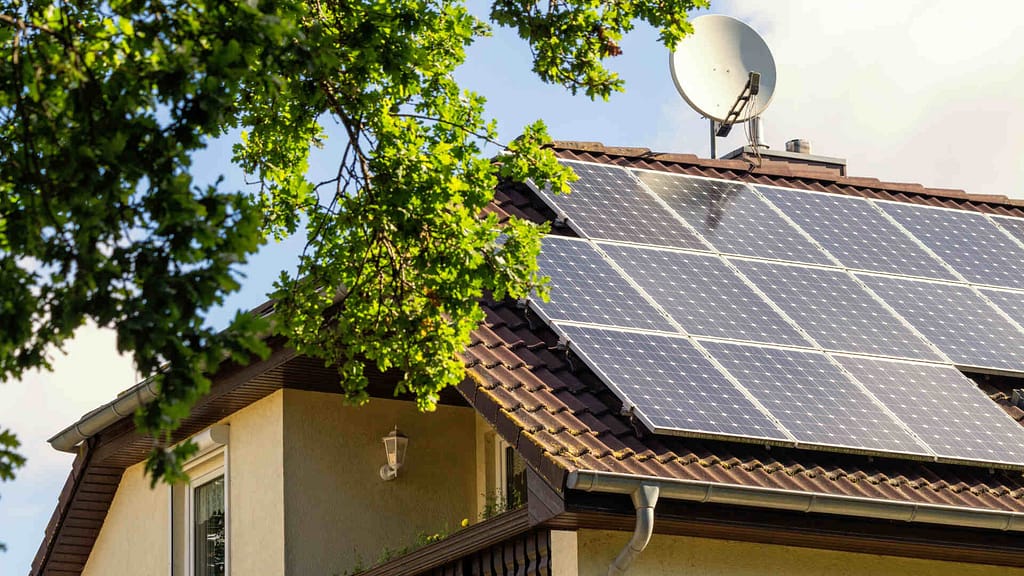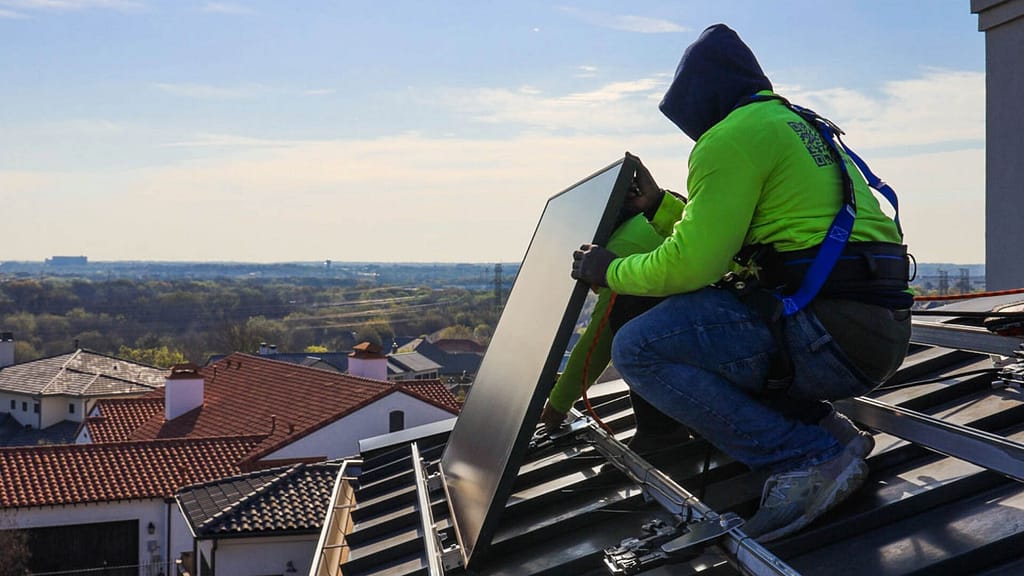Determining how many solar panels you need involves assessing your energy usage, local sunlight availability, panel efficiency, and roof space. This blog post will guide you through these factors, helping you make an informed decision tailored to your home or business’s specific requirements.
Table of contents
Factors Influencing the Number of Solar Panels Needed

When deciding how many solar panels you need, several factors come into play. Let’s explore each one to ensure you make the best choice for your home.
Household Energy Usage
Start by looking at your electricity bills from the past year, focusing on the kilowatt-hours (kWh) used each month. Add up all the kWh from the months, then divide by 12 to get your monthly average. This number shows how much power you use and will help guide the number of solar panels you need.
Knowing how much energy you consume each month helps you understand the scale of solar system required to meet your needs. It can also inspire you to reduce consumption before switching to solar, making the transition more cost-effective.
Sunlight Availability
Your home’s geographic location is a key factor in determining the potential of solar energy production. This is because the amount of sunlight that reaches different parts of the Earth varies significantly depending on latitude and local climate conditions.
Besides the baseline intensity of sunlight, geographic location also influences seasonal variations. In equatorial regions, day length and sunlight intensity remain relatively constant throughout the year. However, further from the equator, these factors change significantly with seasons. In these areas, solar panels produce more electricity in the summer when days are longer and the sun is higher in the sky, and less in the winter when the sun is lower and the days are shorter.
Panel Efficiency
Solar panel efficiency is a measure of how well a panel converts sunlight into electricity. Higher efficiency panels are more expensive but require less space because they generate more power from the same amount of sunlight. Depending on your space availability and budget, choosing more efficient panels could reduce the total number of panels needed.
Roof Space and Orientation
The amount of usable roof space you have limits the number of panels you can install. The direction your roof faces also affects performance—south-facing roofs typically harvest more sunlight in the Northern Hemisphere.
To maximize efficiency, avoid areas shaded by trees or other structures. Consider using tilt frames to angle panels towards the sun if your roof doesn’t have an ideal slope. Professional installers can help determine the best configuration to get the most out of your solar panels.
Types of Solar Panels

When choosing solar panels for your home or business, it’s important to understand the different types available, as they can impact both the efficiency and the number of panels you will need.
- Monocrystalline Solar Panels: Manufacturers create monocrystalline panels from a single, continuous crystal structure. These panels are known for their high efficiency and sleek, dark appearance. Because they are more efficient at converting sunlight into electricity, you might need fewer monocrystalline panels than other types to meet your energy needs. However, they can be more expensive, which is something to consider in your budget.
- Polycrystalline Solar Panels: Polycrystalline solar panels are made from fragments of silicon crystals melted together. These panels have a bluish hue and are less efficient compared to monocrystalline panels, but they come at a lower cost. Because of their lower efficiency, you may need more polycrystalline panels to achieve the same energy output as fewer monocrystalline panels.
- Thin-Film Solar Panels: Thin-film panels are made by layering one or more thin films of photovoltaic material onto a substrate. These panels are the least efficient of the three types but are also the most lightweight and flexible, making them suitable for a variety of surfaces where traditional panels might not be ideal. Due to their lower efficiency, more thin-film panels are usually required to generate the same amount of power as fewer crystalline panels.
Impact on Panel Quantity
The type of solar panel you choose directly affects how many panels you’ll need. More efficient panels like monocrystalline require fewer units to generate the same amount of power as more but less efficient polycrystalline or thin-film panels. Therefore, your choice depends on the available space for installation and how visually discrete you want the setup to be. It’s essential to consider these factors along with initial costs and long-term energy production goals when deciding how many and what type of panels to install
Choosing the Right Installer

When you decide to go solar, selecting the right installer is as important as choosing the right solar panels. Good Faith Energy, a leading solar panel installer in Dallas and Austin, Texas, excels in customizing solar solutions to fit various residential and commercial needs. They back every installation with commercial-grade products and comprehensive warranties, ensuring reliability and quality. By choosing Good Faith Energy, you’ll benefit from expert guidance on the exact number of solar panels required for your specific energy usage and roof specifications, ensuring your setup is both efficient and effective.
In addition to their expertise in installation, Good Faith Energy is a Tesla Certified Installer and one of the top-rated solar businesses in Texas, with stellar reviews across major platforms like Google, Yelp, and Facebook. Their wide range of services includes everything from initial solar assessments to ongoing maintenance and repairs, helping you maintain an energy-efficient, economical, and sustainable environment. Whether you’re looking to install new panels or optimize an existing system, Good Faith Energy provides the necessary expertise to accurately determine how many solar panels you need to meet your energy goals.
Conclusion
Determining the number of solar panels you need for your home or business involves a thoughtful consideration of several crucial factors, including your household energy usage, the availability of sunlight in your area, the efficiency of the panels themselves, and the physical space available for installation. By understanding these elements, you can make an informed decision that balances your energy needs with your budget and space constraints. Additionally, the type of solar panels you select—whether monocrystalline, polycrystalline, or thin-film—will directly influence the number of panels required to achieve your desired energy output. Each type offers unique benefits and efficiencies, and your choice will depend on specific conditions and preferences.
Choosing the right installer is just as important as selecting the correct type and number of panels. Good Faith Energy, a trusted and highly-rated installer in Texas, provides not only high-quality, reliable installations but also invaluable expertise in customizing solar solutions that meet individual needs. Their comprehensive service guides you through every step of the process, from choosing the right type of panels to the final installation, to maximize the efficiency and sustainability of your solar energy system. By partnering with a reputable installer like Good Faith Energy, you can ensure that your solar investment is sound and that your transition to renewable energy is smooth and successful. For a free estimate of solar panel installation, you can use our solar calculator, to start planning your project today.
Fact checked by Jacob Petrosky – 5/1/2024